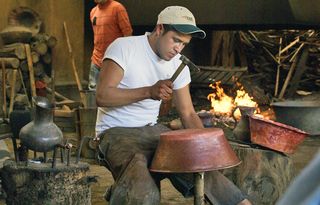
Hand-hammering the finish in a Santa Clara del Cobre copper workshop. Many of the copper artisans' tools are made by the men themselves in order to meet the specific needs of their work.
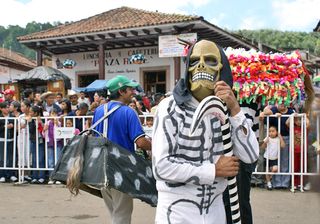
Death fights a bull at the parade for the 2010 Feria Nacional del Cobre (National Copper Fair).
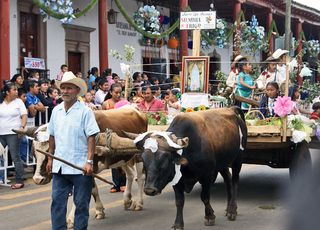
Carros alegóricos (parade floats) pulled by ox teams represented the stages of crop growth. This one is called "siembra del trigo"–sowing the wheat.

This carro alegórico represents la milpa (the corn field).
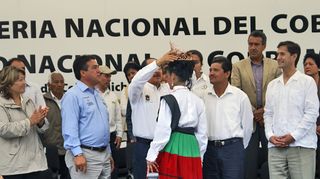
Michoacán's governor, Leonel Godoy Rangel, crowns Berenice Saucedo as the 2010 Reina del Cobre (Copper Queen).

La reina Berenice (center) and her two princesas Citlali graciously posed for Mexico Cooks!. Yes, both princesses were coincidentally named Citlali. Note the tiny copper pitcher on the top of the queen's scepter–and the copper crowns and jewelry made just for the occasion.
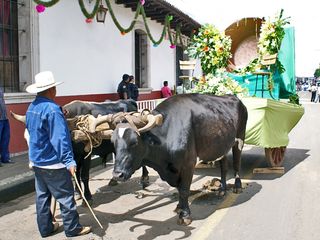
La Reina Berenice and her princesses, Citlali Nuñez and Citlali Maldonado, rode through the parade crowd in this cart.

Other floats were built on trucks. Unión de Artesanos Pito Pérez (a copper workers' union) decorated this truck bed with the typical roof of a troje (Purhépecha building), tissue paper flowers, and handmade garlands of huinumo (pine needles).
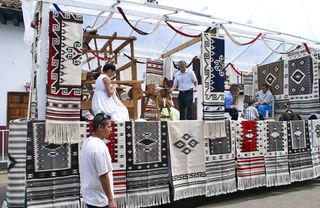
In addition to copper, woven textiles are part of the artisan culture of Santa Clara del Cobre. Weavers and their looms rode the parade route on this flatbed truck.
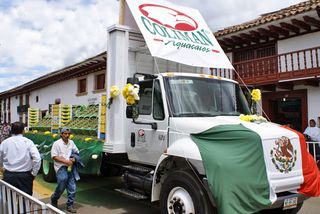
Coliman, with acres of orchards near Santa Clara, produces huge quantities of Hass avocado, better known in Michoacán as oro verde (green gold). This truck, decorated for the parade and loaded with crates of avocados, barely fit on the narrow main street of town.

This flatbed float is dedicated to Don Vasco de Quiroga, who arrived in Michoacán in 1531 and worked with the indigenous population to raise the quality of artisan work made in this region. Click on any photo to see detail.
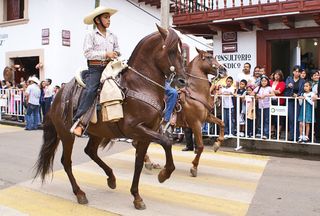
After the floats passed by, the parade treated the crowd to local men and boys on dancing horses.
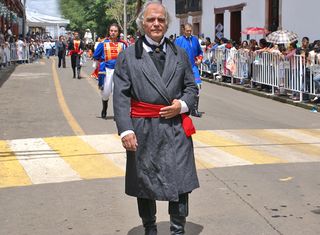
And after the horses, heroes of Mexico's 1810 struggle for independence marched by–here, Padre Miguel Hidalgo, who gave the initial grito (cry) for independence on the night of September 15, 1810.

Other men from Santa Clara represented foot soldiers from Mexico's 1910 revolution. The instant after I snapped this photo, the man in the red shirt jovially pointed his mock-up gun at me!

In the traditional copper workshops of Santa Clara, wood fires are still made to blaze with a hand-and-foot operated bellows.

Incredibly complex and beautiful copper artistry comes from this elegant copper shop. The glowing copper pots, on the left are hand enameled with monarch butterflies (a symbol of the state of Michoacán). The dark finish on the pots in the foreground is entirely natural, not applied. Each pot is hand-hammered from a solid ingot–each pot is seamless.
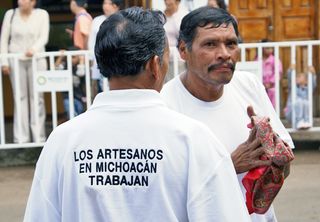
The shirt tells the story: 'los artesanos en Michoacán trabajan' (the artisans of Michoacán work).

Join Mexico Cooks! at the August 2011 Feria Nacional del Cobre. Email me for dates!
Looking for a
tailored-to-your-interests specialized tour in Mexico? Click here: Tours.

Leave a Reply to Gigi Taylor Cancel reply